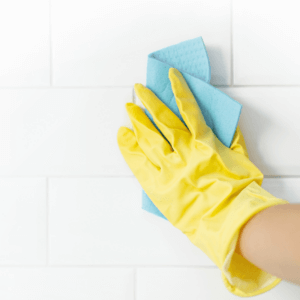Mould Cleaning in the Bathroom: Prevention & Cleaning Tips
Mould Cleaning in the Bathroom: Prevention & Cleaning Tips
Key Takeaways
- Proper Ventilation is Crucial: Running an exhaust fan during and after showers, and opening windows enhance air circulation, which is vital for preventing mould growth in bathrooms.
- Regular Cleaning Regimen: Cleaning the bathroom weekly with mould-inhibiting products helps prevent the accumulation of mould spores, focusing especially on areas prone to moisture like grout and beneath sinks.
- Use of Effective Cleaning Products: Choosing the right mould removal products, ranging from commercial solutions to natural alternatives like vinegar and bicarbonate soda, is essential for effectively combating mould.
- Humidity Control: Maintaining indoor humidity levels below 50% using tools like dehumidifiers and hygrometers can significantly reduce the likelihood of mould development.
- Prompt Attention to Leaks: Regular inspections and timely repair of bathroom leaks are imperative to prevent water damage and reduce moisture, thus helping mitigate mould growth.
Summary
This article provides a comprehensive guide on preventing and removing mould in bathrooms. Key mould cleaning strategies include ensuring adequate ventilation, maintaining regular cleaning routines, using effective mould-removal products, controlling humidity levels, and promptly repairing leaks. It emphasizes the importance of daily habits and the use of natural prevention techniques to maintain a healthy, mould-free bathroom environment.
Bathrooms are often hotspots for mould growth due to the high humidity and constant exposure to moisture. Addressing mould in the bathroom not only contributes to a cleaner and more aesthetically pleasing space but also promotes a healthier living environment. This comprehensive guide will cover effective strategies for both preventing and eliminating mould in your bathroom, ensuring it remains clean and hygienic.
Understanding Mould: Causes and Risks
Mould thrives in moist, warm environments, making bathrooms an ideal breeding ground. Common causes of mould in bathrooms include lack of ventilation, lingering moisture, and leaks. The presence of mould can lead to various health issues, including respiratory problems, allergies, and skin irritation, underscoring the importance of timely and effective removal.
Effective Ventilation: A Key Preventative Measure
Ensuring proper ventilation is paramount in preventing mould growth. An exhaust fan should run during and for at least 30 minutes after showers and baths to help mitigate moisture. Regularly opening windows and doors can also promote air circulation, significantly reducing the potential for mould buildup.
Daily Practices to Minimise Moisture
Simple daily habits can effectively reduce moisture levels in the bathroom, curtailing mould growth. Using a squeegee to wipe down the walls and shower doors after each use removes excess water and speeds up drying. Additionally, keeping the bathroom door open after use will further improve air circulation.
Routine Cleaning to Keep Mould at Bay
Regular cleaning is essential in preventing mould formation. Weekly cleaning of all surfaces with a mould-inhibiting cleaner can prevent spore accumulation. Pay special attention to grout lines, shower corners, and beneath sinks where mould is prone to develop.
Choosing the Right Cleaning Products
Selecting appropriate cleaning products is crucial for effective mould removal. Options range from commercial mould removers to natural solutions like vinegar and bicarbonate soda. For non-porous surfaces, a solution of one part bleach to ten parts water can be effective. However, ensure the area is well-ventilated when using harsh chemicals.
Deep Mould Cleaning for Stubborn Mould
In cases of persistent mould, a more intensive mould cleaning may be necessary. This might involve using a steam cleaner to penetrate deep into grout lines and other hard-to-reach areas. For silicone sealant plagued by mould, replacement might be the best option as it’s difficult to clean thoroughly once stained.
Sealing Grout for Long-Term Protection
Applying a silicone-based grout sealer after mould cleaning can prevent moisture penetration and mould growth. This protective barrier should be reapplied annually, or as recommended by the product manufacturer, to maintain its effectiveness.
Monitor and Repair Leaks Promptly
Regularly inspecting bathroom fixtures and plumbing for leaks is crucial. Prompt repairs not only prevent water damage but also mitigate mould growth by reducing moisture levels.
The Importance of Humidity Control
Maintaining a bathroom humidity level below 50% can significantly hinder mould growth. A hygrometer can be used to monitor the humidity levels. If necessary, employing a dehumidifier can help maintain optimal conditions, especially in bathrooms without adequate natural ventilation.
Natural Mould Prevention Strategies
Incorporating plants that absorb humidity, such as peace lilies or orchids, can naturally help reduce moisture in the air. Additionally, opening curtains and blinds to let in sunlight will naturally disinfect the area, prevent mould growth and reduce mould cleaning through UV exposure.
Mould in the bathroom can be a persistent issue, but with proper preventative measures and regular mould cleaning, it can be effectively managed. By understanding the conditions that foster mould growth and implementing strategies to mitigate these factors, you can maintain a clean, healthy, and mould-free bathroom.
FAQs
What is the best way to remove mould from bathroom surfaces?
The most effective way to remove mould from bathroom surfaces is by using a solution of bleach diluted with water or a vinegar-based solution. It’s important to wear protective gloves and ensure the area is well-ventilated during the cleaning process.
How often should I clean to prevent mould growth in my bathroom?
Regular cleaning is crucial to prevent mould growth. It’s recommended to clean bathroom surfaces at least once a week with mould-inhibiting products and to address any moisture accumulation immediately, such as wiping down the walls and floors after a shower.
Are there any natural alternatives for mould removal?
Yes, natural alternatives like white vinegar, baking soda, and tea tree oil are effective against mould. These substances can be used alone or in combination to clean affected areas safely and effectively, offering a less toxic alternative to chemical cleaners.
Why Choose Us?
AllAces Cleaning & Restoration has over 35 years of industry experience handling extensive mould cleaning and remediation projects across Brisbane, Sydney, Melbourne and surrounds. Our IICRC-certified technicians utilise the latest technology and equipment to ensure the return of a pre-loss condition.


